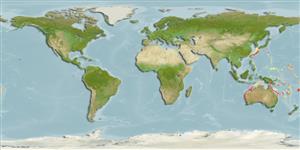>
Perciformes/Scorpaenoidei (Scorpionfishes) >
Bembridae (Deepwater flatheads)
Etymology: Bembras: Greek, bembras, -ados = a kind of anchovy (Ref. 45335); longipinnis: Named for the long pectoral fin of the fish..
Environment: milieu / climate zone / depth range / distribution range
Ecologia
marino demersale; distribuzione batimetrica 143 - 215 m (Ref. 27966). Subtropical
Western Pacific: northern (Cape Don, Arafura Sea) to northwestern Australia (north of North West Cape, Port Hedland and Nickol Bay) (Ref. 27966).
Size / Peso / Age
Maturity: Lm ? range ? - ? cm
Max length : 20.0 cm SL maschio/sesso non determinato; (Ref. 27966)
Short description
Morfologia | Morfometria
Raggi anali molli: 13 - 14. Head depressed. Body without large scute-like spines. Infraorbital bones forming a strong ridge, confluent with uppermost preopercular spine and having 4-6 spines. Ratio of pectoral-fin length to caudal fin length 1.05 to 1.15 (Ref. 40506).
Occurs over soft bottom of the continental shelf and continental slope. Benthic (Ref. 75154).
Life cycle and mating behavior
Maturità | Riproduzione | Deposizione | Uova | Fecundity | Larve
Imamura, H. and L.W. Knapp, 1998. Review of the genus Bembras Cuvier, 1929 (Scorpaeniformes: Bembridae) with description of three new species collected from Australia and Indonesia. Ichthyol. Res. 45(2):165-178. (Ref. 27966)
IUCN Red List Status (Ref. 130435)
Threat to humans
Harmless
Human uses
Informazioni ulteriori
Nomi ComuniSinonimiMetabolismoPredatoriEcotossicologiaRiproduzioneMaturitàDeposizioneSpawning aggregationFecundityUovaEgg development
Age/SizeAccrescimentoLength-weightLength-lengthLength-frequenciesMorfometriaMorfologiaLarveDinamica popolazioni larvaliReclutamentoAbbondanzaBRUVS
BibliografiaAcquacolturaProfilo di acquacolturaVarietàGeneticaElectrophoresesEreditarietàMalattieElaborazioneNutrientsMass conversion
CollaboratoriImmaginiStamps, Coins Misc.SuoniCiguateraVelocitàModalità di nuotoArea branchialeOtolithsCervelliVista
Strumenti
Special reports
Download XML
Fonti Internet
Estimates based on models
Preferred temperature (Ref.
123201): 14.3 - 21.5, mean 20.4 °C (based on 19 cells).
Phylogenetic diversity index (Ref.
82804): PD
50 = 0.5332 [Uniqueness, from 0.5 = low to 2.0 = high].
Bayesian length-weight: a=0.00389 (0.00180 - 0.00842), b=3.12 (2.94 - 3.30), in cm total length, based on all LWR estimates for this body shape (Ref.
93245).
Trophic level (Ref.
69278): 3.7 ±0.5 se; based on size and trophs of closest relatives
Fishing Vulnerability (Ref.
59153): Low vulnerability (14 of 100).
